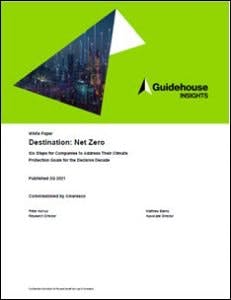Green resiliency: Securing your stride in the race to net zero
As net-zero corporate pledges continue to rise, there is increasing focus on the specific pathways companies will be taking to achieve these goals. Additionally, investors have been stepping up the pressure for organizations to set and meet net-zero goals, some even threatening to pull money out of companies that don’t take action. There’s good reason for these goals; a BloombergNEF analysis found that the top 167 corporate polluters meeting net-zero goals would result in global carbon emissions reductions of over 20%.
However, reasons for decarbonizing go beyond stakeholder pressure. With increasing awareness of the numerous benefits of decarbonization, organizations across multiple industries, including the public sector, are setting net-zero goals.
Short- and long-term considerations
The most obvious motivations for setting net-zero goals are environmental and financial. In recent years, these two areas have converged; it’s now cost-effective and even financially beneficial to reduce emissions.
Get this Guidehouse report on 6 Steps Companies Can Take to Reach Net Zero
Less obvious benefits include your organization’s image and stakeholder engagement, even among your own employees. This became clear to us at a client ribbon-cutting event we attended earlier this year for the largest behind-the-meter solar project in Iowa, which will directly offset carbon loads at Wells Fargo’s campus in Des Moines. Despite the below freezing temperatures, the event was surprisingly well attended by employees, who clearly felt a sense of pride about the company’s commitment to the environment.
Decarbonization benefits like these are enduring, with short-term benefits translating into long-term rewards. That’s especially clear when it comes to financial benefits; while many commercial entities can start saving money immediately with solar, the savings increase over time because the stable solar energy costs provide a hedge against inflation and a volatile energy market.
Establishing a baseline and determining next steps
Because your organization has unique needs based on factors like size, goals, finances and geographic region, there’s no one-size-fits-all path to decarbonization. But starting with these steps will help ensure success:
- Determine your priorities. While cost savings are always desirable, resilience has become a key driver for many businesses and municipalities in the face of increasing power outages. Of course, resilience priorities vary depending on your needs: hospitals and data centers have much less tolerance than other organizations for even short outages. Environmental, social and governance (ESG) goals may also play an important role in your organization.
- Collect data on current emissions. With today’s increased focus on ESG, numerous platforms are available to help measure scope 1, 2 and 3 emissions as defined by the GHG Protocol: your organization’s direct and indirect emissions, as well as indirect emissions from your value chain. Ameresco has developed our own in-house measurement solution, which we use to help many of our customers and, as part of our own ESG commitments, we are using this technology to measure our own carbon footprint. These platforms serve a double purpose as they are also key for accurate ESG reporting.
- Set realistic goals for the entire process. A goal of net zero by 2050 is meaningless without a path to get there, but it can be powerful when linked to achievable short- and medium-term goals. For example, Ameresco is working with a customer on a large project that will incorporate fuel cells but will be ready to transition to hydrogen when that becomes viable. A customer wanting a 100% renewable energy microgrid might keep existing gas or diesel generators as part of the initial design, with a plan to phase those out as they reach their end of life and batteries become more affordable.
While your specific needs and priorities will determine which decarbonization actions your organization should take, a best practice is to start by finding ways to reduce your energy use. Solar and storage get a lot of attention, but the cheapest, cleanest energy is the energy you don’t use in the first place; right sizing your energy use first will ensure that you don’t overbuild any solar you install.
When you’ve reduced your energy use, you can then move on to sourcing clean energy. Many organizations have been meeting their decarbonization goals with renewable energy certificates (RECs). RECs are market-based instruments through which renewable energy generation and use claims are substantiated in the renewable electricity market.
Much more effective than using RECs is to add solar — and potentially even storage — to your facility. There is ample siting potential on rooftops and parking lots for solar panels, which can significantly lower your energy costs. Adding energy storage may also be a good option; if your facility has high demand charges, you could see large energy bill reductions. If resilience is a priority, you may even want to install a microgrid.
Securing financing
Even the best-thought-out goals can’t be achieved without the necessary capital. A number of solutions are available to ease the transition to net zero, with the most common financing mechanism for commercial-scale renewable energy projects being a power purchase agreement (PPA) or a similar “energy-as-a-service” model.
But you may want to consider a more creative, holistic approach. When Ameresco partnered with the Metropolitan Airports Commission, which owns and operates Minneapolis-St. Paul International Airport (MSP), it was initially considering a traditional PPA for a solar project. By changing its thinking to incorporate the demand side along with the supply side, MSP was able to use the savings it gained from converting to LED lighting to help pay for its solar system — while increasing its positive environmental impact.
Taking a holistic approach to financing also means considering your entire portfolio of projects. If each project has to pencil out, a project in California might fare better than one in Iowa because of the cost of energy in each state. But in a large portfolio, some projects may help to carry the others.
Setting authentic targets and adapting as needed
Many companies are revisiting how they meet their decarbonization goals. RECs, which have been used widely, play an important role in accounting, tracking and assigning ownership to the generation and use of renewable electricity, and they have been instrumental in the transition to renewable energy. But RECs have come under scrutiny recently because using the energy from a potentially distant power plant is not the same as powering your operations directly with renewable energy.
Wells Fargo, for example, started with a 2050 decarbonization goal that it was meeting in part with RECs. As generating renewable energy locally became more feasible, the company made the decision to meet its decarbonization goal with more local projects, which they are rolling out in nearly 100 locations in eight states.
You may find that a changing environment leads you to adapt your goals and the methods you use to achieve them. Evaluating your progress — which you can do with the same platforms you use to measure your current carbon emissions — can help you measure success and adapt as needed.
Tying it all together with microgrids
While getting to net zero has been categorized as a race, there is a need to set a pace and consider a holistic approach with a diverse combination of solutions to reach the finish line. With technology advancing in the clean energy space, organizations can and should apply complementary solutions to achieve these goals.
Microgrids are a core part of this holistic approach and the piece that links the various solutions together. Of course, a microgrid needs to be considered as just one part of your holistic approach, which begins with looking at where you can reduce your energy use. And you may find that it makes sense for your facility to combine approaches like solar and wind generation, energy storage, cogeneration and demand-side management.
A microgrid ties these all together while delivering linked benefits — adding resilience to the already significant benefits of cost and carbon reductions, meeting ESG goals and enhancing the credibility of your organization’s net-zero goals.
Bob Georgeoff is executive vice president at Ameresco. Leila Dillon is senior vice president of marketing and communications at Ameresco. Get this Guidehouse report on 6 Steps Companies Can Take to Reach Net Zero











